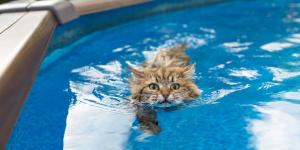Differences Between a Spanish Water Dog and a Portuguese Water Dog



See files for Dogs
A dog's attitude to water is based largely on experience and personal preference. Breed can be a factor, especially for one group of dog breeds. These are breeds known as water dogs. They are so called thanks to centuries of selective breeding which has encouraged certain behavioral traits. Specifically, this dog was bred and trained to be a good swimmer. The reason was so they could be used as working dogs in and around bodies of water. Whether as a ship's dog, water rescuer or even dock worker, these dogs continue to prove invaluable to many aquatic workers across the world. Two of the most popular and well known are the Spanish Water Dog and the Portuguese Water Dog. They are also two breeds which are often confused with each other.
AnimalWised tries to lesson this confusion by looking at the differences between a Spanish Water Dog and a Portuguese Water Dog. We break down the characteristics of both so you can recognize which is which the next time you come across them.
- Origins of the Spanish Water Dog
- Physical characteristics of the Spanish Water Dog
- Spanish Water Dog temperament
- Origins of the Portuguese Water Dog
- Physical characteristics of the Portuguese Water Dog
- Portuguese Water Dog temperament
- Differences between Spanish vs. Portuguese Water Dog breeds
- Other water dog breeds
Origins of the Spanish Water Dog
To better know the differences between the Spanish vs. Portuguese Water Dog breeds, we should look at where they both originate. Both of these types of water dog breeds have ancient origins, meaning it can be difficult to determine their exact lineage. It also means there is some variation in the breed, although all of them will conform to a certain breed standard.
We do know the origins of the Spanish Water Dog date back to the arrival of Muslims in the Iberian Peninsula as they traveled through Andalusia. This occurred around the year 711 CE. For this reason, it was previously known as the Andalusian Turkish Dog or Turkish Water Dog.
However, there are contradictory reports that this dog may also have African origins. This claim was that North African tribes used these dog for herding and water work, eventually crossing the water to the Iberian Peninsula.
Regardless of the exact origin, we know the breed as we know it today was developed in Spain. They were developed mainly in Andaluz, as well as the northern coastal regions. They were very useful dogs for centuries, but the Industrial Revolution meant their roles waned in importance, especially as fishing was taken further out to sea. They were close to extinction by the 1970s, but were saved by local breeders who wanted to ensure their line continued.

Physical characteristics of the Spanish Water Dog
According to the World Canine Federation (FCI), the Spanish Water Dog has been employed as a working dog for herding, hunting and water retrieving. The latter makes them great working dogs for various aquatic industries, as well as water rescue dogs. This is largely due to the following characteristics of Spanish Water Dogs:
- Body: medium with a harmonious shape.
- Height: between 17-20" (44-50 cm) for males and 16-18" (40-45 cm) for females at the withers.
- Weight: between 40-49 lb (18-22 kg) for males and 31-40 lb (14-18 kg) for females.
- Physical build: muscular and athletic with an excellent predisposition for physical exercises.
- Tail: mostly long and with a medium insertion (some specimens are born with a short tail).
- Nose: pigmented in a color similar to or slightly darker than their coat tone.
- Coat: woolly and curly with males usually forming cords when their hair is sufficiently long. The coat colors accepted within the official standard are black, brown and white in different shades, as well as the bicolor black and white, and brown and white. There are tan, hazelnut, and bicolor tan and black specimens, but they are not considered to conform to the official breed standard. Their coat is also considered hypoallergenic, making it a more suitable dog for people with allergies and respiratory problems.
Learn more about handling allergies around canines with our article on hypoallergenic dog breeds.
Spanish Water Dog temperament
It is important to remember that the most important factors in a dog's personality are socialization, experience and education. However, it is true that certain breeds were bred to have particular character traits, whether as a specific breeding goal or as a byproduct of engendering other traits. This is the case with the Spanish Water Dog.
Spanish Water Dogs are said to be intelligent and obedient dogs which learn easily when properly stimulated. Their temperament is usually balanced, but they are also faithful and brave. Their desire to perform well as family guardians is one of the main reasons they are used regularly as water rescue dogs. It makes them protective and loving, in addition to their working skills as hunters and retrievers.
Origins of the Portuguese Water Dog
Despite both the Spanish Water Dog and the Portuguese Water Dog being developed on the Iberian Peninsula, they are not necessarily the closest relation to each other. One theory suggests they have the same common ancestor, specifically the aforementioned Turkish Water Dog. However, other sources claim they may be more closely related to the Poodle.
Regardless of their very early beginnings, it was in Portugal that the modern Portuguese Water Dog (also known as a Portie or simply PWD) was developed. They also had a similar problem due to technological advancements in industry. For example, they were once used to send messages between boats, but this was made redundant thanks to the development of radio.
It was in the 1930s in Portugal that this breed was saved from potential extinction. This was thanks to the establishment of a breeding program by a well-known shipping magnate of the time. This program was so intensive, it is said that about half of all PWDs can be traced back to one single dog known as Leão.
Although still popular across Europe, the Portuguese Water Dog is very popular in the United States of America, more so than the Spanish Water Dog. This was thanks to a breeding program established in the 1970s which eventually led to the Portuguese Water Dog Club of America, Inc. (PWDCA).
Perhaps the most noted Portuguese Water Dog to date is a dog named Bo. He was the dog of the Obama family, during and after Barack Obama's presidential administration. He was given the honorary title of ‘First Dog’ and helped to boost the popularity of this breed worldwide.

Physical characteristics of the Portuguese Water Dog
According to the FCI, the PWD has very similar working roles as the Spanish Water Dog. They are incredible hunters, retrievers and companion animals. Their physical characteristics are the following:
- Body: medium with a harmonious shape.
- Height: 20-22" (50-57 cm) for males and 17-20" (43-52 cm) for females at the withers.
- Weight: 42-60 lb (19-27 kg) for males and 35-50 lb (16-23 kg) for females.
- Physical build: they are robust dogs whose musculature develops very easily, becoming resistant to physical wear and fatigue.
- Tail: mostly long with a broad base tapering to the tip and medium set.
- Nose: dogs with black fur and bicolor specimens have a black nose. Brown-haired dogs usually have a brown nose.
- Coat: the breed includes 2 types of coat. One is long and wavy and other is curly, but both are considered hypoallergenic. The official standard accepts white, black and brown coats, as well as white and brown, and black and white.
Portuguese Water Dog temperament
Like the Spanish water dogs, the Portuguese specimens tend to learn very easily and quickly. Their character is also very similar to his Iberian relative, being a cheerful and playful dog, with a balanced and courageous temperament. They are usually content to wait by their guardian's side to receive orders, something which is important for working water dogs as they wait on the shore.
PWDs tend to bond more with an individual in a family, even if they are a good dog for all of the group. While they have a very even temperament, they need plenty of physical and mental stimulation to avoid boredom and stress. Since they are known retrievers, they have a habit of catching small items and can become destructive, especially if they become bored. However, they have a low prey drive and can happily live with other dogs and even cats.
Differences between Spanish vs. Portuguese Water Dog breeds
The first notable difference between these two races is related to their origins. Despite sharing the Turkish Dog as a common ancestor, these two breeds were developed in different countries, Spain and Portugal. If we look carefully at the physical characteristics of the Spanish and Portuguese water dog, we can list other differences. The most important differences are the following:
- Height: the Portuguese water dog is usually taller than their Spanish relative. The difference in height being around 4" (10 cm) in males and 2" (5 cm) in females.
- Weight: the Portuguese Water Dog is also usually heavier than the Spanish Water Dog, thanks to their greater height and more developed musculature.
- Physical build: both breeds are of medium size and have an athletic body, but Portuguese Water Dogs tend to develop their musculature more easily, being much more robust than Spanish Water Dogs.
- Coat: unlike the Spanish Water Dog, the Portuguese accepts 2 types of coat. A curly-coated Portuguese Water Dog is usually very similar to a Spanish water dog, but the differences become noticeable when we look at longhaired, wavy-coated Portuguese Water Dogs.

Other water dog breeds
If you like Portuguese and Spanish specimens, surely you will also love the other breeds of water dogs:
- Barbet from France
- American Water Dog or American Water Spaniel from the United States
- Friesian Water Dog or Wetterhoun from the Netherlands
- Irish Water Dog known as the Irish Water Spaniel from Ireland
- Poodle from France
- Lagotto Romagmolo from Italy
- Moscow Water Ddog Russia
- Cantabrian Water Dog from northern Spain
The Cantabrian Water Dog breed was originally considered a sub-type of the Spanish Water Dog, but was later proclaimed to be a separate species with similar origins.

If you want to read similar articles to Differences Between a Spanish Water Dog and a Portuguese Water Dog, we recommend you visit our Comparisons category.








